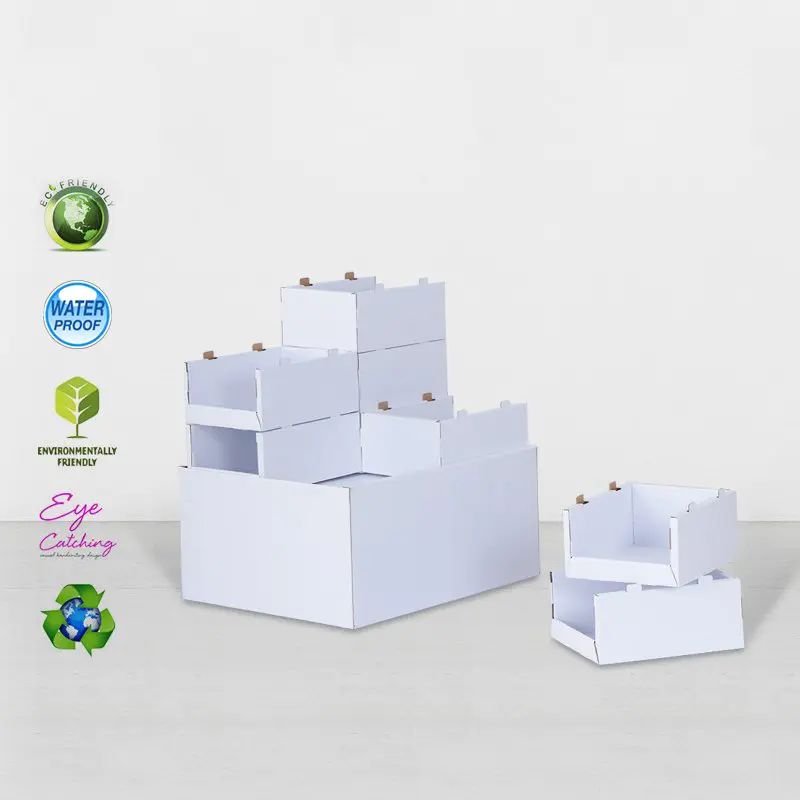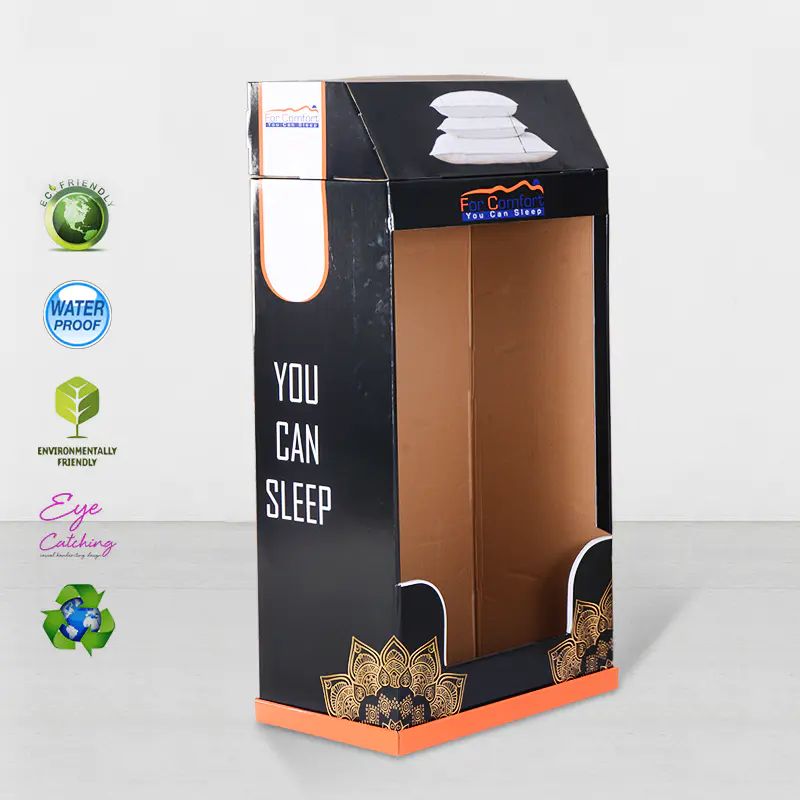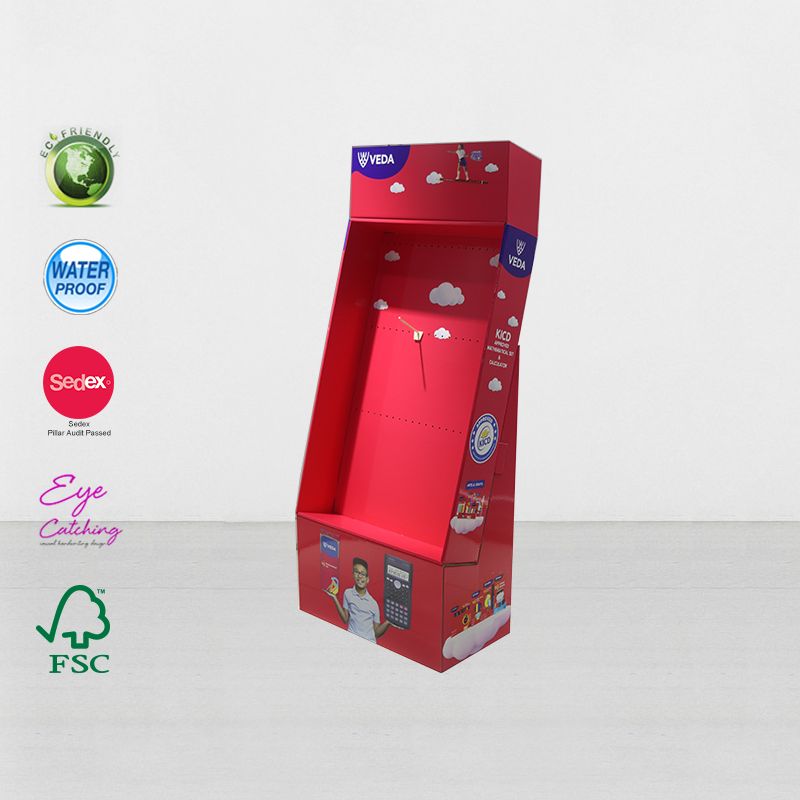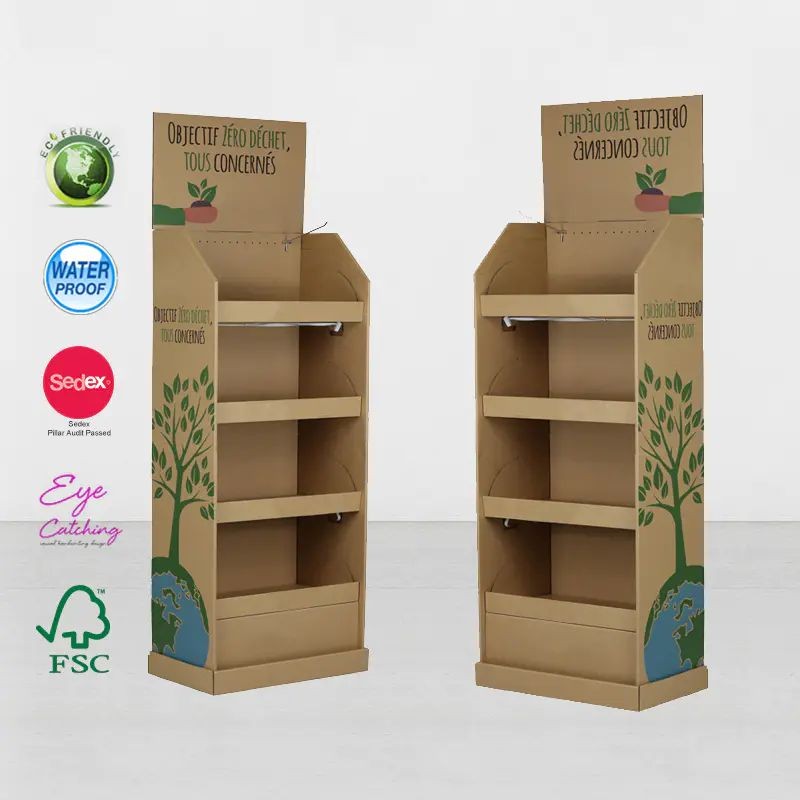In retail and promotional settings, display stands are crucial tools for product display and brand promotion. Consumers' attention is often captured within seconds of entering a store. As a visual guide and sales aid, the material used in display stands directly impacts product stability, display effectiveness, and cost-effectiveness.
Therefore, understanding the material selection criteria and performance characteristics of display stands is crucial for retailers, brand owners, and display designers. Among them, corrugated cardboard display stands are widely used in modern retail due to their unique advantages. So, what is the best material for display stands?
This article will professionally analyze the selection of display stand materials from multiple perspectives, including material properties, structural design, manufacturing process, load-bearing capacity, and application scenarios, focusing on the characteristics and applicability of corrugated cardboard display stands.

Display Stand Materials: Classification and Performance Standards
Display stands can be categorized into the following categories based on their material:
1. Corrugated Cardboard Display Stand
• Material: Primarily composed of face paper, corrugated core paper, and lining paper, with single-, double-, or triple-wall construction.
Features:
• Lightweight: Easy to transport and handle;
• Environmentally friendly: Paper materials are recyclable;
• Highly printable: High-quality color printing is possible, displaying branding and promotional information;
• Low cost: More economical to produce than metal or plastic displays.
• Applications: Short-term promotions, quick displays, new product launches, retail center islands, and entrance areas.
2. Metal Display Racks
• Materials: Common steel, aluminum, and alloys.
Features:
• High load-bearing capacity, suitable for displaying heavy merchandise;
• Durable, long-term use;
• Multi-layer structures and complex designs are possible.
• Limitations: Heavy weight, resulting in high shipping costs; Relatively high production costs; Limited visual flexibility and printing space.
3. Wooden Display Racks
• Materials: Plywood, solid wood, or MDF
Performance Characteristics:
• Natural and beautiful appearance enhances brand image;
• Medium load-bearing capacity, suitable for supporting medium-sized products;
• Customizable shapes and number of layers.
• Limitations: Long processing cycle; high cost; relatively inconvenient transportation and handling.
4. Plastic Display Stands
• Materials: Polypropylene (PP), polyvinyl chloride (PVC), etc.
Performance Characteristics:
• Lightweight, corrosion-resistant, and easy to clean;
• Can be molded into complex shapes for strong visual appeal;
• Medium load-bearing capacity, suitable for light and medium-sized products.
• Limitations: Not as environmentally friendly as cardboard; limited printing flexibility.
Summary: Considering both performance and cost, corrugated cardboard display stands offer significant advantages in terms of lightweight, printability, and cost control.

Corrugated Cardboard Display Stands: What are the structural design advantages?
1. Multi-layer Corrugated Design
Corrugated cardboard display stands offer different load-bearing capabilities through single-, double-, and triple-corrugated designs:
• Single-corrugated: Suitable for lightweight merchandise, with a typical shelf load capacity of 2–10 kg.
• Double-corrugated: Suitable for medium-weight merchandise, with a load capacity of 10–50 kg.
• Triple-corrugated or reinforced: Suitable for heavyweight displays, with a load capacity exceeding 100 kg.
2. Column and Backboard Reinforcement
• Columns utilize longitudinal corrugation or a spliced structure to enhance compressive strength.
• Backboard reinforcement reduces lateral tilt and improves overall stability.
• The integrated shelves and base ensure stability under uneven loads.
3. Modular Design
• Detachable structure facilitates transportation and storage.
• Can be stacked to create promotional islands or center-of-store displays.
• Quick assembly design allows products to be directly transported and sold, improving terminal display efficiency.

Corrugated Cardboard Display Stand: What is its load-bearing capacity?
1. Single-layer Load-Bearing Capacity
• Standard single-wall corrugated panels: Approximately 2–10 kg;
• Reinforced single or double-wall corrugated panels: Up to 10–20 kg.
2. Multi-layer Load-Bearing Capacity
• Three-layer design: The entire stand can bear approximately 20–50 kg;
• Reinforced ribbed or pallet base design: The entire stand can bear over 100 kg.
3. Factors Affecting Load-Bearing Capacity
• Material weight (face and lining paper) and corrugated core strength;
• Fluting type selection (A, B, C, E fluting);
• Number of layers, backing, and base reinforcement design;
• Operating environment (humidity, stacking method).
Conclusion: The load-bearing capacity of a corrugated cardboard display stand can meet diverse display needs, from lightweight to heavyweight merchandise.
Cardboard Display Stands: Manufacturing Process and Printing Advantages
1. Die-Cutting and Folding
• Using precision die-cutting tools, cardboard is cut into bases, columns, shelves, and back panels.
• Folding, splicing, or gluing creates a three-dimensional frame.
• Reinforcement or slots enhance overall stability.
2. Printing and Surface Treatment
• High-quality four-color printing: allows for display of brand logos, promotional information, and product images.
• Lamination or UV treatment: enhances wear resistance, moisture resistance, and gloss.
• Flexible design meets the needs of visual guidance and advertising in retail stores.
3. Cost and Environmental Advantages
• Low production costs, suitable for mass production and seasonal promotions.
• Paper materials are environmentally friendly and recyclable, meeting sustainable development requirements.
• Compared to metal or plastic display stands, they offer lower shipping costs and are easier to transport.

Application Scenarios for Corrugated Cardboard Display Stands
1. Supermarkets and Convenience Stores
• Entrance promotional areas, shelf ends, and checkout counter displays;
• Lightweight construction facilitates quick stocking and frequent replenishment.
2. Mall Island Displays
• Multiple corrugated cardboard display stands can be combined to create an island display, enhancing product exposure;
• Color printing and branding can guide consumers toward purchase.
3. Temporary Promotions and New Product Launches
• For temporary displays or short-term promotions, corrugated cardboard display stands are low-cost and easy to transport;
• Ready-to-use out of the box, improving display efficiency.
Comparison of Corrugated Cardboard Display Stands with Other Display Materials
Material Type | Weight Capacity | Printing and Visual Effects | Cost | Use Cycle | Applicable Applications |
| Corrugated Cardboard Display Stand | 2–100 kg | High, color printing available | Low–Medium | Short to medium term | Supermarkets, promotional areas, center islands, convenience stores |
| Metal display stand | Over 100 kg | Limited | High | Long term | Heavy goods, long-term display |
| Wooden display stand | 50–200 kg | Medium, customizable | High | Medium to long term | High-end brands, aesthetically pleasing displays |
| Plastic display stand | 10–80 kg | Moldable, limited printing | Medium–High | Medium term | Lightweight goods, corrosion resistance requirements |
Conclusion: Taking into account cost, load-bearing capacity, printing flexibility, and transportability, corrugated cardboard display stands offer significant advantages in retail outlets, promotional displays, and short-term displays, making them the most cost-effective display material.
What are the requirements for the optimal display material?
The optimal material for display stands should take into account the following factors:
1. Load-bearing capacity: meeting the weight requirements of the merchandise displayed;
2. Structural stability: ensuring safe display at the point of sale;
3. Cost control: adapting to the economics of promotions and mass production;
4. Visual impact: enhancing brand exposure and sales momentum;
5. Environmental friendliness and transportability: meeting logistics costs and sustainable development requirements.
Among these factors, corrugated cardboard display stands, with their lightweight, environmentally friendly, highly printable, and low cost advantages, are the optimal choice for retail and promotional applications. Through multi-layer corrugation, backing reinforcement, and reinforced design, they can accommodate a wide range of products, from lightweight to heavyweight, while ensuring efficient display right out of the box.
Are you looking for a professional cardboard display supplier in China?
Caiyijie Printing provides high-quality retail display solutions with over 21 years of experience. Our 20,000-square-meter factory and 180 skilled employees specialize in designing and manufacturing customized displays such as Cardboard Floor Displays, Hook Displays, Sidekick Displays, PDQ Boxes, Dumpbins, Cutouts, and Large Packaging Boxes.
With advanced printing, laminating, die-cutting, and gluing equipment, we can fulfill bulk orders, wholesale quotes, and promotions at low prices while maintaining premium quality standards for brands worldwide.

